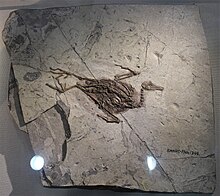Gansus
| Gansus | |
|---|---|

| |
| Fossil specimen, Beijing Museum of Natural History .
| |
| Scientific classification | |
| Domain: | Eukaryota |
| Kingdom: | Animalia |
| Phylum: | Chordata |
| Clade: | Dinosauria |
| Clade: | Saurischia |
| Clade: | Theropoda |
| Clade: | Avialae |
| Clade: | Ornithuromorpha |
| Genus: | †Gansus Hou & Liu, 1984 |
| Type species | |
| †Gansus yumenensis Hou & Liu, 1984
| |
| Other species | |
| |
Gansus is a
Description
melanosomes in Gansus and extant (C, D) feathers[4]
The genus Gansus contains a single species, G. yumenensis,pigeon and similar in appearance to loons and diving ducks.[5] It had many features common among modern birds, and also retained some basal traits such as its clawed wings.[5]
Gansus was discovered in the form of a single fossil foot in 1981. Five more well-preserved fossils were found in 2003–2004 in
flight feathers and traces of the webbing between their toes.[5] In 2011, there were described nine additional specimens, that supported on the basis of a statistic analysis of the sternum and elements of the legs, the hypothesis that Gansus was a volant bird.[6]
You et al. (2006) concluded that the anatomical characteristics of Gansus were similar to foot-propelled diving birds, such as Phalacrocoracidae), suggesting that Gansus was both volant and capable of diving to some degree using either foot-propelled or, perhaps, both its wings and its feet for underwater locomotion.[7]
Classification

Gansus was described as the oldest known
hummingbirds and eagles, are descended from basal ornithurans, many of which were semi-aquatic. It is now thought possible that all modern birds descended specifically from a semi-aquatic bird similar to Gansus. Thus, while Gansus is not necessarily a direct ancestor of today's birds, it is closely related to such an ancestral species.[5] This hypothesis was corroborated by later phylogenetic studies that included this taxon.[3][8]
References
- ^ Ji, S.-A. Atterholt, J. O'Connor, J.K. Lamanna, M.C. Harris, J.D. Li, D.-Q. You, H.-L. & Dodson, P. (2011) A new, three-dimensionally preserved enantiornithine bird (Aves: Ornithothoraces) from Gansu Province, north-western China. Zoological Journal of the Linnean Society 162(1):201–219.
- ^ a b c Hou, L. & Liu, Z. (1984) A new fossil bird from Lower Cretaceous of Gansu and early evolution of birds. Sci. Sin. Ser. B. 27:1296−1302.
- ^ a b O’Connor, J.K & Zhou, Z. (2012) A redescription of Chaoyangia beishanensis (Aves) and a comprehensive phylogeny of Mesozoic birds. Journal of Systematic Palaeontology.
- ^ Barden, H.E. et al. (2011) Morphological and Geochemical Evidence of Eumelanin Preservation in the Feathers of the Early Cretaceous Bird, Gansus yumenensis. PLoS ONE 6(10):e25494.
- ^ a b c d e You, H.-L. Lamanna, M.C. Harris, J.D. Chiappe, L.M. O'Connor, J.K. Ji, S.-A. Lu, J.-C. Yuan, C.-X. Li, D.-G. Zhang, X. Lacovara, K.J. Dodson, P. & Ji, Q. (2006) A Nearly Modern Amphibious Bird from the Early Cretaceous of Northwestern China. Science 312:1640-1643.
- ^ a b Li, Y. Zhang, Y.-G. Zhou, Z.-H. Li, Z.-H. Liu, D. & Wang, X.-L. (2011) New material of Gansus and a discussion on its habit. Vert. PalAs 49:435–445.
- ^ Nudds, R.L, Atterholt, J. Wang, X. You, H.-L. & Dyke, G.J. (2013) Locomotory abilities and habitat of the Cretaceous bird Gansus yumenensis inferred from limb length proportions. Journal of Evolutionary Biology 26(1):150–154.
- ^ O'Connor, J.K., Gao, K.-Q. & Chiappe, L.M. (2010) A new ornithuromorph. (Aves: Ornithothoraces) bird from the Jehol Group indicative of higher− level diversity. Journal of Vertebrate Paleontology 30:311–321.
